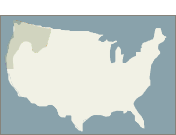Tribes: Pacific Northwest


Karuk Cultural Burning
Karuk aboriginal territory, situated in Northern California, is composed of dense redwood and mixed conifer forests on the Klamath Mountain Ranges following the Klamath River. The territory spans 1.038 million acres entering Southern
Oregon. In the early 1850s California Tribes and the US government negotiated 18 different treaties that allocated California tribes 8.5 million acres, however, these treaties were not accepted by the U.S Senate. In 1905, President
Theodore Roosevelt dedicated vast swaths of Karuk aboriginal territory as public lands in the name of Klamath Forest Reserves. Presently, of that land, the Karuk Tribe has reclaimed under 5000 acres total. Due to decades of excluding
Indigenous forest management, the forest has suffered ecologically. In addition, the region is experiencing warmer and drier seasons, which affect the fuel loads on the ground, increasing potential for a fire. Historically, fire season in
Northern California began in June or July and ended in October, however, there is now additional fire potential from February to May.1
Use of Fire
The Karuk Tribe burned in cycles and seasons depending on what the area needed; some areas were burned every 3-5 years and others every 7-10 years. As the hunting season would come to an end – typically in late fall –
Karuk members would ignite an area. As each burn cycle was completed, the area was restored with new vegetation. The fire regime within Karuk ancestral territory includes high frequency burns with low to moderate
severity. While the term “damage” can have a negative connotation, the damage caused by these cultural burns were beneficial to the land, killing off saplings and clearing the area for new vegetation to emerge. In addition to
these environmental benefits, there were also significant benefits to the people, such as improved visibility while hunting, and new shoots of plants for both humans and animal relatives.
Suppression of Cultural Burning
In spite of the ecological benefit that the Karuk Tribe provided the land through the use of fire, the 1850 Act for the Government and Protection of Indians outlawed this Tribal practice, further criminalizing these
ancestral traditions. Fire suppression measures within the U.S. began in the 1800s. However, it was in 1910 after the “Big Burn” fire that the U.S. Forest Service made a greater effort to suppress fire more efficiently,
causing the development of new policies. The Big Burn was not one mega fire, instead it was a series of many fires over 5 million acres that burned vast amounts of land in Idaho, Montana, and Washington leading to
large amounts of public feedback. Years later, in 1935, the 10AM Policy was enacted. The 10AM Policy mandated that any wildfire, regardless of the cause of ignition, needed to be put out by 10AM the following
day. After WWII is truly when fire suppression has become more efficient due to the surplus of wartime equipment which advanced the ability to prevent and suppress fires. Considering the changes in laws and policies
from the 1800s to the 1900s, Karuk land had barely been touched with fire, allowing the buildup of fuel loads in a dense overgrown forest, and a reduction in biodiversity. Without fire, native conifers began encroaching
on other species within the area. This has hindered the ability of the other native species to thrive, causing a loss of resources and ability to gather for Karuk people. The Karuk's use of fire was monumental in the
health of the forest, and withholding the fire from the land for so long in combination with climate factors led to conditions that could lead to high-severity burns, such as the Slater fire that burned in 2020.
Current Status
Traditionally, Karuk managed the land with fire through cultural burnings. These fires protected Tribal lands, facilitating a healthy forest ecosystem. Cultural burnings aided in the creation of a heterogenetic forest
through close management by the Karuk Tribe allowing the trees within the forest to age differently, aiding in the health of the forest. The Karuk’s use of fire was vast; they not only burned near their communities but
also in the mountains away from their villages. Having fire reach these areas allowed the land to be revitalized and therefore protected from future wildfires becoming out of control, like we are now seeing not only
in California, but across the world. Within the last seven years California has seen five of the largest fires the state had ever had, all surpassing 390,000 acres. The second largest fire was the Dixie fire in Northern
California, which burned 963,309 acres. The fire ignited when a Douglas fir fell onto a power line. The fire was pushed by a dry state, fuel build up and strong winds. Due to changing weather patterns and associated
drought, many areas are now affected with prolonged warm and dry seasons, increasing the risk of uncontrollable wildfires. Fire has an impact on germination and the growth of certain plants, however in Northern
California there is a lack of western science knowledge about fire regeneration with the local plants due to a lack of research within that area on post fire floras.
Loss of Tradition
Karuk members and their descendants have, since time immemorial, known the importance of fire and the role that they played in the health of the land around them. Although the use of cultural burning was outlawed, some
Karuk members would risk their freedom to continue this practice. They understood the consequences, but the health of their land was of far greater importance. In retrospect it is clear why Karuk members may have
risked the use of this vital cultural practice. All actions were to protect the land that has provided them with the resources that make up their food sources and way of life.
"The lack of fire in our communities and in our territory has impacted a lot of different things — not just the risk of high severity burns in our communities, but it’s impacted our diets and it’s impacted our
cultural lifeways. It’s impacted our babies". - Neva Gibbens, Deputy Director of Natural Resources, Karuk
The lack of cultural fire in Karuk territory has had devastating impacts for the community as they continue to see traditions and cultural burning practices being negatively impacted by reduced quality and disappearance
of resources once found in abundance on their lands. The connection between basket making and fire stems from the lack of fire in the region which in the past had helped the quality of the sticks used to weave baskets.
For the Karuk, Traditional basketry is just one example of a practice threatened by fire suppression. Without a good supply for baskets, elders face challenges with passing down this vital tradition to the coming generations.
Often, baskets woven today are not as sturdy or strong as those woven in previous generations. Despite techniques remaining the same it is the quality of materials harvested and access to them that has diminished. Lower
quality sticks are sometimes hollow or buggy due to a lack of regenerative fire which eliminate bugs and allows the plant to grow fresh, strong shoots. Areas where good quality sticks are found can often be harder to access,
making them less available to community members. Additionally, in some years, the sticks can no longer be found. Neva Gibbens, Deputy Director of the Karuk Tribe Department of Natural Resources, noticed a stark contrast
between the baby basket woven for her husband, and the baby basket woven for her son. The larger baby basket that was woven for her son did not last; instead, they had resorted to using the father’s infant basket that
was woven about 45 years ago. Neva was heartbroken knowing that her son had lost precious time in his own basket that could have held him for much longer had it been as sturdy as the father’s basket.
Partnership Rooted in Tradition
In the last 15 years the Karuk Tribe has participated in prescribed burning guided by their past use of fire. With the use of beneficial fire, they have seen changes in the landscape, as life was brought back to the
Northern California region. The burnings not only revitalize the land, but the reduction in fuel loads provides protection for surrounding communities and has built more positive relationships between the Forest Service
and Karuk community. The partnership between the Mid Klamath Watershed Council and Salmon River Restoration Council allowed for a collaborative effort to be made to manage the land and for these organizations to work on
different projects together, such as fishery management, water quality, and fire. To enact a prescribed burn there are a series of protocols to follow, whereas cultural burning involves Tribes determining their own
qualifying factors to entrust individuals from the community who possesses the Traditional Ecological Knowledge needed to enact the burn. Protocols and permitting for a prescribed burn are lengthy, as a burn plan that
details how the fire will be managed and precautions that will be taken to ensure the safety of all involved must be created. Cultural burning respects and recognizes Tribal Sovereignty and Traditional Ecological
Knowledge (TEK) to determine the most efficient and safe methods to burn, including the timing, location, and methods used. Each Tribe may define cultural burning differently as they may come from different regions or
hold different insights, even those located in nearby territories.
California Senate Bill 310 (SB310
The SB310 bill, proposed by Senator Scott Wiener and Assembly Member Matt Haney, addresses cultural burning practices as prescribed fire and civil liability around prescribed fires replacing the prohibition of cultural
burning. In 2025, SB310 will go into effect, furthering Tribal rights to cultural burning in Northern California. This bill helped to strengthen Tribal sovereignty and authority by recognizing the right to use
their cultural burning once again on their ancestral lands. With the passing of SB310, federally recognized California tribes now are able to burn on their lands with the use of a Cultural Fire Practitioner. A Cultural
Fire Practitioner is an individual who possesses Traditional Ecological Knowledge in the use of burning, this individual would be recognized by the Tribe to have a vast amount of knowledge in this practice. Previously,
for a cultural burn to take place, certain requirements had to be met, such as having a written risk mitigation plan or a burn prescription. Essentially having the Tribes ask for permission to burn on their own lands,
rather than it being their sovereign right to manage their own lands within their jurisdiction. However, with the passage of SB310, those are no longer required. Before SB310, the process for conducting a cultural burn
was nearly identical to that of a prescribed burn. The key change brought by the bill is that cultural burns are no longer viewed in the same way as prescribed burns. This shift acknowledges that cultural burns are a
Traditional practice for Northern Californian Tribes, and the State recognized its past wrongs in criminalizing this important cultural tradition. Individuals of the Karuk Tribe are thrilled to be a part of this change
in process and immediately began practicing this cultural management strategy in early 2025 with a formal agreement between the Tribe and the State of California.
References: